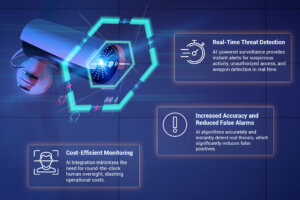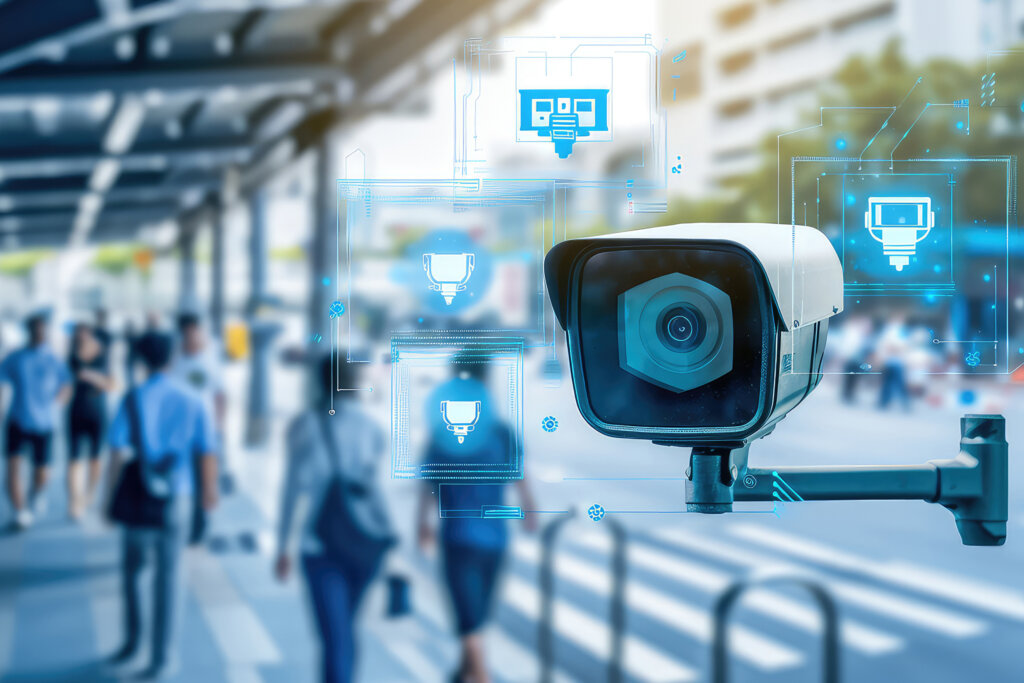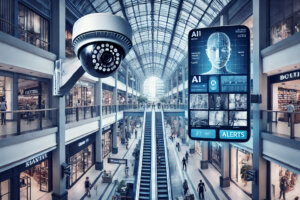AI Integration in Surveillance: Upgrading Legacy Systems

Artificial intelligence (AI) is redefining the future of surveillance, making systems smarter, faster, and more responsive. From real-time threat detection to reducing false alarms, AI integration offers some transformative advantages.
Yet a common misconception persists: that legacy surveillance systems can’t support AI.
In reality, many existing installations can be enhanced with AI-powered capabilities. All without a complete overhaul.
The key lies in knowing how to modernize strategically.
This article explores how to strategically implement AI into legacy surveillance systems, the common hurdles to expect, and the long-term benefits of AI integration.
Key Limitations of Legacy Security Systems
Legacy surveillance systems once met the mark. Today, they’re falling behind. Many outdated implementations struggle to keep pace with the rising complexity of modern security demands in schools, workplaces, and public spaces.
Consider the data:
In 2021, U.S. schools reported over 857,500 violent incidents. In New York City alone, subway homicides surged by 60%. Nationwide, the Council on Criminal Justice found that between 2019 and 2024, gun assaults rose 5%. Shoplifting saw a 1% spike, and motor vehicle thefts increased by 53%.
Figure 1. Percent Change in Violent Offenses, 2019 – 2024
Of course, crime is shaped by broader social and economic forces. But the limitations of outdated surveillance systems are increasingly difficult to ignore. Traditional CCTV installations simply aren’t designed to proactively address today’s evolving threats. Here’s why:
- Limited Threat Detection: Relying on manual monitoring, legacy systems often miss subtle behavioral cues or anomalies.
- No Real-Time Intelligence: Without AI integration, footage is only useful after the fact. This issue causes delayed responses when every second counts.
- Scalability Challenges: Expanding a legacy system typically leads to performance bottlenecks, blind spots, or costly infrastructure upgrades.
In a world where threats evolve rapidly, the question is no longer if AI integration is needed but how soon it can be implemented.
Bringing Legacy CCTV Into the Future with AI Integration
AI integration is the catalyst for transforming outdated surveillance systems into intelligent, responsive security solutions. Thanks to advancements in machine learning, pattern recognition, and real-time video analytics, legacy CCTV infrastructure can be upgraded.
The best part? You can accomplish this without a complete overhaul.
Instead of operating reactively, older camera systems can now detect threats proactively. With AI integration, they can analyze behavior in real time and support faster decision-making across diverse environments.
Here are three ways AI and CCTV integration can breathe new life into your existing security setup:
1. Real-Time Threat Detection and Proactive Response
With AI integration, existing security cameras can analyze video feeds in real time. This enables immediate threat detection and faster response times. Such a proactive approach enhances security by reducing the time between identifying and addressing potential threats.
2. Advanced AI Video Analytics for Smarter Surveillance
Unlike legacy systems, AI models offer efficient data management and analysis to recognize patterns and identify potential incidents. With AI video analytics, pre-existing security systems can instantly and accurately detect intruders, guns, crowds, and even loitering. Security teams can make informed decisions by identifying subtle anomalies and suspicious behavior.
3. False Positive Reduction
Legacy systems often flood security teams with false alarms triggered by irrelevant motion—wasting time and resources. AI-powered CCTV integration addresses this by filtering out non-threatening events using advanced AI algorithms.
AI and CCTV Integration: Key Challenges and Smart Solutions
AI implementation can seem overwhelming, especially when working with legacy surveillance infrastructure. But with the right approach, you can overcome common obstacles and transform your existing setup into a next-generation security solution.
Here are three AI integration challenges (and how to solve them effectively):
Compatibility with Legacy Systems
Older CCTV systems were built for basic recording and storage—not for real-time data processing or intelligent analytics. This lack of built-in AI technology creates a technical gap.
The Solution: Modern AI surveillance software is designed to retrofit seamlessly with existing hardware. By offloading processing to cloud-based or edge computing platforms, these solutions enable AI-powered features—such as threat detection—without requiring a full system replacement. This dramatically reduces costs and minimizes operational disruption.
The Complexity of AI Software
AI and CCTV integration can feel daunting, particularly for teams without technical expertise. The complexity of deploying AI solutions can overwhelm staff, slowing down the transition and hindering efficiency.
The Solution: Adopting AI tools designed with simplicity in mind can ease the learning curve. Clear, step-by-step integration and ongoing support help teams gradually adapt, ensuring a smoother transition without major disruptions.
Scalability and Future-Proofing Your Surveillance System
As businesses and facilities grow, their security demands increase. Unfortunately, legacy systems often struggle to scale, leading to performance issues and coverage gaps.
The Solution: Top-tier AI applications work seamlessly with new devices, so your system remains efficient and fully functional as it expands. This makes it easy to adapt as your security requirements evolve.
The Top 3 Benefits of AI and CCTV Integration


AI-driven CCTV integrations offer numerous benefits. They make existing security systems smarter, more efficient, and incredibly cost-effective. Beyond better threat detection and reduced false alarms, AI-powered surveillance provides these key advantages:
1. Real-Time Threat Detection and Faster Incident Response
AI surveillance solutions instantly analyze video feeds to flag suspicious activities like unauthorized access, loitering, and weapon detection. This saves time and allows for quick responses, helping security teams or law enforcement step in before an incident escalates.
2. Greater Accuracy in Identifying True Security Risks
Traditional CCTV systems often trigger false alarms, wasting time and resources. AI integration leverages computer vision and pattern recognition to accurately detect real threats. This, in turn, reduces false positives, so your security team focuses on legitimate concerns, not false alerts.
3. Cost Reduction Through Automated Monitoring
AI minimizes the need for constant human oversight by automating video analysis and alert generation. This reduces labor costs and improves operational efficiency, allowing teams to allocate their attention to high-priority threats (rather than continuous manual surveillance).
Future-Proofing Security with AI Integration
The future of security and surveillance lies in AI integration. As threats become more sophisticated, AI will be the key to staying ahead. With real-time analysis, predictive threat detection, and seamless integration, AI transforms traditional systems into proactive, intelligent solutions.
AI-powered surveillance provides the technological advancements and real-time insights that organizations need to stay secure. Those who embrace AI now will be better prepared for the challenges of tomorrow.
Ready to future-proof your security?
Explore Actuate’s AI surveillance integrations or book your demo to discover how AI can turn your existing surveillance system into a powerful security asset.




